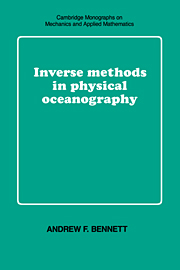Book contents
- Frontmatter
- Contents
- Preface
- 1 Finite-dimensional inverse theory
- 2 The smoothing of observations
- 3 Data assimilation
- 4 The spatial structure of the Kalman filter
- 5 Generalized inverses of dynamical models
- 6 Antenna analysis
- 7 Nonlinear quasi-geostrophic models
- 8 Open-ocean modelling: quasi-geostrophy
- 9 Primitive-equation models
- 10 Outstanding problems
- Bibliography
- Subject index
6 - Antenna analysis
Published online by Cambridge University Press: 08 January 2010
- Frontmatter
- Contents
- Preface
- 1 Finite-dimensional inverse theory
- 2 The smoothing of observations
- 3 Data assimilation
- 4 The spatial structure of the Kalman filter
- 5 Generalized inverses of dynamical models
- 6 Antenna analysis
- 7 Nonlinear quasi-geostrophic models
- 8 Open-ocean modelling: quasi-geostrophy
- 9 Primitive-equation models
- 10 Outstanding problems
- Bibliography
- Subject index
Summary
Introduction
A generalized inverse estimate of ocean circulation is a field which nearly solves an ocean circulation model and which nearly fits a finite set of data. It is intuitively obvious that if several of the data were collected at almost the same place or at almost the same time, yet had widely differing values, then fitting the data closely would be very difficult. Any field which did fit would tend to fluctuate wildly in an extended neighborhood of the observing sites. However, if the data were assumed to possess significantly large errors, then a relatively well behaved field might be able to come consistently close to the data: see Fig. 6.1.1. Nevertheless it would be concluded that there is redundancy in the data.
The concepts “almost the same place or time,” “significantly large error” and “well behaved” are defined relative to the scales and amplitudes of the circulation, as characterized by the stream-function, for example. In a generalized inverse estimate the scales and amplitudes are those of the initial errors, the dynamical errors, and the internal scales of the dynamics. The initial and dynamical information is contained in covariances such as A and Q in §5.6, and in the dynamical operator L appearing in §5.2. The measurements are completely described by the functionals C, and the measurement error covariance matrix such as, also defined in §5.6.
It is shown in this chapter that for linear dynamics, the redundancies in the observing system or “antenna” may be determined from these parameters and operators.
- Type
- Chapter
- Information
- Inverse Methods in Physical Oceanography , pp. 151 - 180Publisher: Cambridge University PressPrint publication year: 1992



